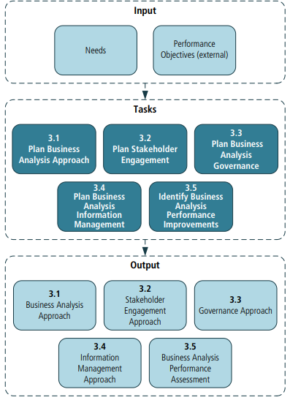Business Analysis Planning and Monitoring
The Business Analysis Planning and Monitoring knowledge area tasks organize and coordinate the efforts of business analysts and stakeholders. These tasks produce outputs that are used as key guidelines for the other tasks throughout the Core Standard. The Business Analysis Planning and Monitoring knowledge area includes the following tasks –
- Plan Business Analysis Approach
- Plan Stakeholder Engagement
- Plan Business Anal sis Governance
- Plan Business Analyysis Information Management
- Identify Business Analysis Performance Improvements

| Tasks | Purpose | Description | Input | Output |
| Plan Business Analysis Approach | The purpose of Plan Business Analysis Approach is to define an appropriate method to conduct business analysis activities. | Plan Business Analysis Approach describes the planning of business analysis work from creation or selection of a methodology to planning the individual activities, tasks, and deliverables. | Needs: the business analysis approach is shaped by the problem or opportunity faced by the organization. It is necessary to consider what is known about the need at the time of planning, while acknowledging that understanding evolves throughout business analysis activities. | Business Analysis Approach: identifies the business analysis approach and activities that will be performed across an initiative including who will perform the activities, the timing and sequencing of the work, the deliverables that will be produced and the business analysis techniques that may be utilized. The remaining outputs of the Business Analysis Planning and Monitoring knowledge area may be integrated into an overall approach or be independent based upon methodology, organization, and perspective |
| Plan Stakeholder Engagement | The purpose of Plan Stakeholder Engagement is to plan an approach for establishing and maintaining effective working relationships with the or stakeholders. | Plan Stakeholder Engagement describes understanding which stakeholders are relevant to the change, what business analysts need from them, what they need from business analysts, and the best way to collaborate. | Needs: understanding the business need and the parts of the enterprise that it affects helps in the identification of stakeholders. The need may evolve as stakeholder analysis is performed. Business Analysis Approach: incorporating the overall business analysis approach into the stakeholder analysis, collaboration, and communication approaches are necessary to ensure consistency across the approaches. | Stakeholder Engagement Approach: contains a list of the stakeholders, their characteristics which were analyzed, and a listing of roles and responsibilities for the change. It also identifies the collaboration and communication approaches the business analyst will utilize during the initiative. |
| Plan Business Analysis Governance | The purpose of Plan Business Analysis Governance is to define how decisions are made about requirements and designs, including reviews, change control, approvals, and prioritization. | Plan Business Analysis Governance defines the components of business analysis that are used to support the governance function of the organization. It helps ensure that decisions are made properly and consistently, and follows a process that ensures decision makers have the information they need. | Business Analysis Approach: incorporating the overall business analysis approach into the governance approach is necessary to ensure consistency across the approaches. Stakeholder Engagement Approach: identifying stakeholders and understanding their communication and collaboration needs is useful in determining their participation in the governance approach. The engagement approach may be updated based on the completion of the governance approach. | Governance Approach: identifies the stakeholders who will have the responsibility and authority to make decisions about business analysis work including who will be responsible for setting priorities and who will approve changes to business analysis information. It also defines the process that will be utilized to manage requirement and design changes across the initiative. |
| Plan Business Analysis Information Management | The purpose of Plan Business Analysis Information Management is to develop an approach for how business analysis information will be stored and accessed. | Plan Business Analysis Information Management defines how information developed by business analysts (including requirements and designs) is captured, stored, and integrated with other information for long-term use. | Business Analysis Approach: incorporating the overall business analysis approach into the information management approach is necessary to ensure consistency across the approaches. Governance Approach: defines how business analysts manage changes to requirements and designs, how decisions and approvals for business analysis deliverables will be made, and how priorities will be set. Stakeholder Engagement Approach: identifying stakeholders and understanding their communication and collaboration needs is useful in determining their specific information management needs. | Information Management Approach: includes the defined approach for how business analysis information will be stored, accessed, and utilized during the change and after the change is complete. |
| Identify Business Analysis Performance Improvements | The purpose of Identify business Analysis performance Improvements is to assess business analysis work and to plan to improve processes where required. | Identify Business Analysis Performance Improvements describes managing and monitoring how business analysis work is performed to ensure that commitments are met, and continuous learning and improvement opportunities are realized | Business Analysis Approach: identifies business analysis deliverables that will be produced, activities that will need to be performed (including when they will be performed and who will be performing them), and techniques that will be used. Performance Objectives (external): describe the desired performance outcomes that an enterprise or organization is hoping to achieve | Business Analysis Performance Assessment: includes a comparison of planned versus actual performance, identifying the root cause of variances from the expected performance, proposed approaches to address issues, and other findings to help understand the performance of business analysis processes. |
Are you preparing to become an ECBA certified professional?Take a Quiz

